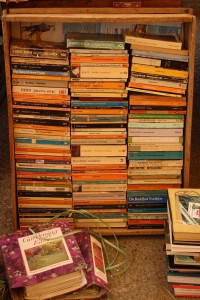
There were two standing ovations that night at the NAPA auditorium in the old Hindu Gymkhana. The audience first rose to its feet when Naseeruddin Shah walked onto the stage to introduce the production, a dramatic retelling of three of Ismat Chughtai’s plays by Motley Theatre, titled Ismat Apa Ke Naam. That ovation was for Shah alone, fueled by the audience’s deep respect for his work in film, and their utter delight at seeing him in the flesh.

Photo credit: Syed Junaid Ahmed.
This production was an experiment of sorts, Shah said in his introduction. The storytellers would employ a mix of narration and acting, with basic use of props, lighting and sound, thus creating a more full-bodied storytelling experience. Karachi audiences had previously seen a simpler version of this being put into practice by Qissah Farosh, which had inserted a basic component of acting in their performance of the works of Patras Bukhari and Mirza Farhatullah Baig, but had stayed faithful to the narrative form of storytelling. Prior to that, Zambeel Dramatic Readings had paid tribute to Ismat Chughtai’s work in a more classical narrative style.
The benefits of the evolved storytelling model are obvious: it allows the narrator to interact with the audience, to react to the material while relaying it, and to laugh off mistakes – all the while maintaining the ambiance of a theatrical production. And so we saw Heeba Shah give a wide grin when she briefly stumbled at one point in her telling of Chhui Muee, a scathing critique of gender and class relations seen through the prism of childbirth. We saw Ratna Pathak Shah stop mid-sentence and chastise an audience member for leaving their cell phone on while narrating Mughal Bacha (originally published as Ghoongat), a funny and also incredibly sad lesson on love and ego. And we saw Naseeruddin Shah chuckle frequently through his telling of Gharwali, a hilarious literary treatise on the patriarchal concept of honour. Of course, given Shah’s skill as an actor, it is perfectly possible that the chuckling was intentional, but the point remains that the storytelling model allowed him to use it.
Over the course of an hour and some minutes, the three actors enthralled the audience with their charged performances. My only peeve was that Mughal Bacha was narrated in too low a voice; the audience had to strain to hear Ratna Pathak Shah. But Ratna Ji also served us one of the evening’s most memorable scenes, in which she prepared to say her prayers while building up to the climax of the story. The quiet, deliberate movements with which she performed the wuzu and wrapped her head scarf created an aura of both piety and dread as we waited to hear what would ultimately become of Kaalay Mian’s and Gori Bi’s unfortunate marriage.
It was testament to the strength of Chughtai’s writing and Shah’s direction that the theatrical aspects of the production never overpowered the stories. It seemed as though the Shah family was simply the channel; ultimately it was Ismat Apa whose voice emerged the strongest – unapologetic, unflinching – and that was exactly how it should have been.

NAPA Chairman Zia Mohyeddin with Naseeruddin Shah and Ratna Pathak Shah. Photo by Fawad Khan.
The second standing ovation of the night came when the actors converged on stage to take their bows. By this time, the applause was not just for Naseeruddin Shah. All three actors had, in their own way and style, owned the stories they had told. They had truly celebrated Ismat Chughtai, and in doing so they had done us a service. As Shah had pointed out in his introduction, Chughtai never got the recognition she deserved in her own country. Despite her obvious literary talents and diverse body of work, she forever became known as the woman who wrote Lihaf. The stories showcased in this production demonstrated that Chughtai was never one to step back from difficult themes, but the mere implication of lesbianism in Lihaf had caused a scandal that she was never quite able to overcome in the course of her career, or indeed even after she died. Every time Motley Theatre performs Ismat Apa Ke Naam, it reclaims some of the space, inch by precious inch, that should legitimately have been hers. And for that we are grateful.
The NAPA International Theatre Festival 2014 is on ’till 27th March. Get details for the event here.





